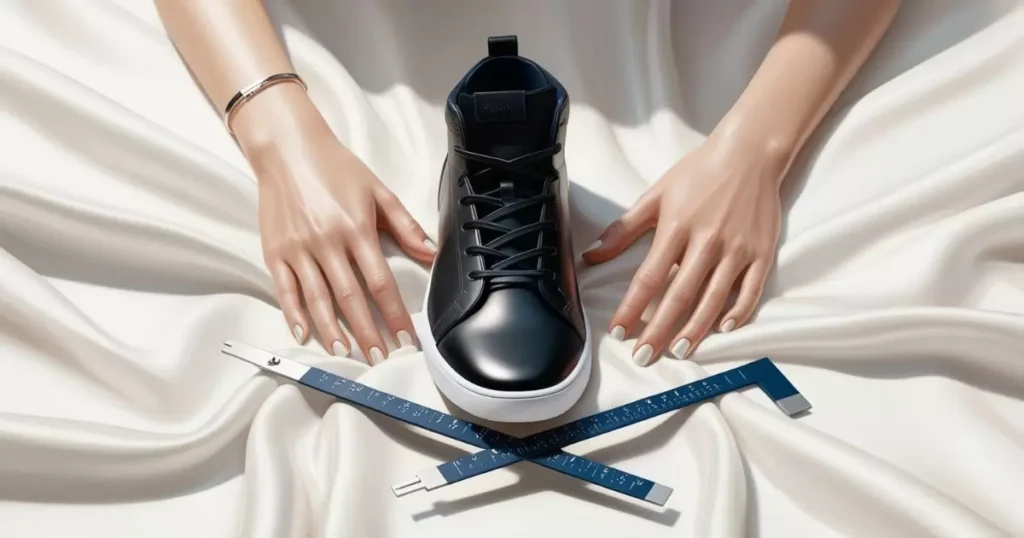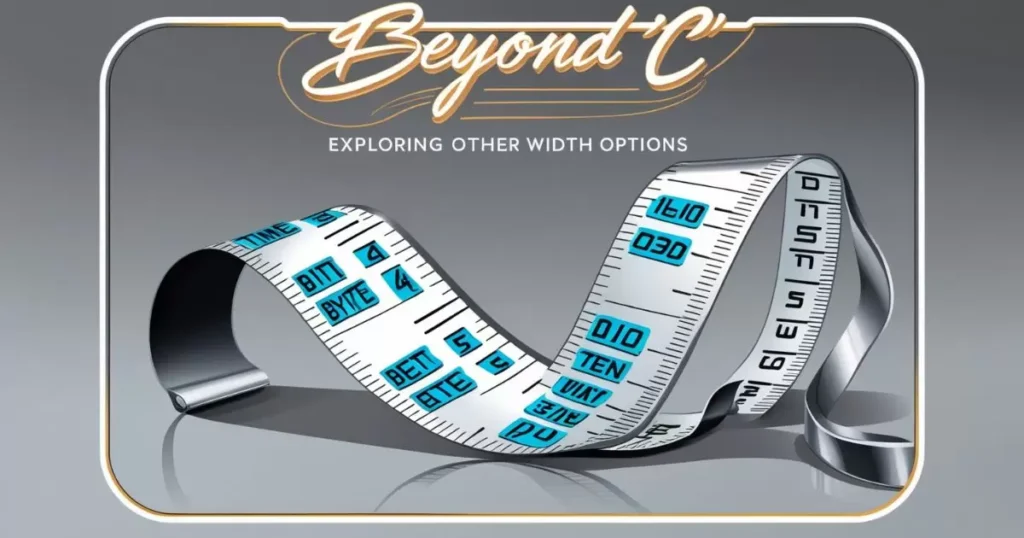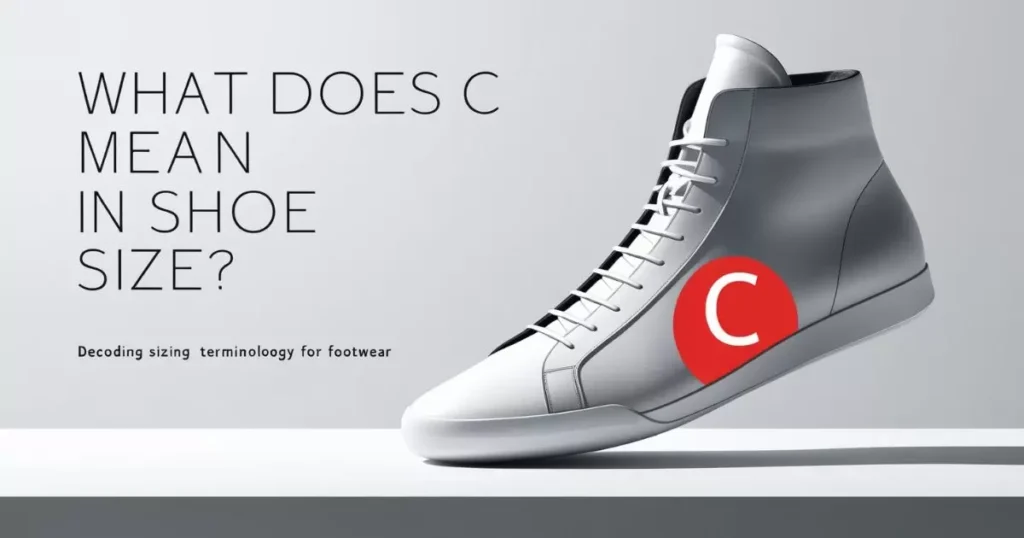Ever stood in a shoe store, puzzled by the mysterious letters on the box? You’re not alone. Today, we’re diving deep into the world of shoe sizing, specifically unraveling the enigma of the ‘C’ width. Whether you’re a seasoned shoe enthusiast or just looking for a comfier fit, this guide will help you step into the perfect pair with confidence.
The ABCs of Shoe Sizing: A Quick Primer
Let’s face it: shoe sizes are about as straightforward as a pretzel. Why? Because feet are as unique as fingerprints. No two are exactly alike, which is why we need more than just length to get that Cinderella fit.
Shoe sizing has come a long way since the 14th century when the English King Edward II decreed that three barleycorns equaled one inch—the basis for our modern shoe length measurements. But length alone doesn’t cut it. Enter width measurements, and suddenly, we’re dealing with a whole new alphabet soup.
Decoding the ‘C’: What It Really Means
So, what’s the deal with ‘C’? In the grand scheme of shoe widths, ‘C’ is smack in the middle of narrow and wide. It’s like the Goldilocks of shoe widths—not too snug, not too roomy.
Here’s a quick rundown of the width spectrum:
- AAA: Narrowest
- AA: Narrow
- B: Slightly narrow
- C: Medium for women, Narrow for men
- D: Medium for men, Wide for women
- E: Wide
- EE/EEE: Extra wide
Surprised that ‘C’ means different things for men and women? You’re not alone. This quirk in sizing is just one of the many reasons why understanding shoe width is crucial for comfort.
Measuring Up: How Shoe Width is Determined

Ever seen that metal contraption in shoe stores that looks like a medieval torture device? That’s a Brannock Device, the gold standard for measuring foot size since 1925. It measures both length and width, giving a comprehensive picture of your foot’s dimensions.
But what if you’re shopping online or just want to check at home? Here’s a DIY method:
- Trace your foot on a piece of paper
- Measure the widest part of the tracing
- Compare your measurement to this chart:
| Foot Width (inches) | Women’s Width | Men’s Width |
| 3.25 – 3.5 | AA (Narrow) | – |
| 3.5 – 3.75 | B (Narrow) | – |
| 3.75 – 4 | C (Medium) | A (Narrow) |
| 4 – 4.25 | D (Wide) | B (Narrow) |
| 4.25 – 4.5 | E (Wide) | C (Medium) |
| 4.5 – 4.75 | – | D (Medium) |
| 4.75 – 5 | – | E (Wide) |
Remember, this is just a guide. Factors like arch height and foot shape can affect the best width for you.
‘C’ Around the World: Global Shoe Size Variations
Think ‘C’ means the same thing everywhere? Think again. Shoe sizing is about as standardized globally as plug sockets—which is to say, not at all.
In the US and UK, ‘C’ is a recognized width measurement, but the meaning can vary:
- US: ‘C’ is medium for women, narrow for men
- UK: ‘C’ is generally narrow for both men and women
Meanwhile, in Europe, width is often denoted by different symbols:
- F: Narrow
- G: Standard/Medium
- H: Wide
And in Japan? They use a completely different system based on centimeters, with ‘E’ being the standard width.
Pro tip: When shopping internationally, always check the brand’s specific size chart. A ‘C’ in one country might leave you swimming (or squeezed) in another.
The Goldilocks Zone: Finding Your Perfect ‘C’
How do you know if you’ve hit the sweet spot with your shoe width? Here are some telltale signs:
Too narrow:
- Pinching at the ball of your foot
- Numbness or tingling in your toes
- Blisters on the sides of your feet
Too wide:
- Your foot slides around inside the shoe
- Blisters on your heel from excess movement
- Difficulty keeping the shoe on without tightening excessively
Just right:
- Snug but not tight fit around the ball of your foot
- About a thumb’s width of space at the toe
- No slipping at the heel
Remember, proper width isn’t just about comfort. It’s crucial for foot health. Too narrow, and you risk issues like bunions and hammertoes. Too wide, and you lose support, potentially leading to plantar fasciitis or ankle sprains.
Beyond ‘C’: Exploring Other Width Options

While ‘C’ might be the Goldilocks width for many, it’s not one-size-fits-all. Let’s break down the other options:
- AA (Super Narrow): Think ballerina feet. Rare, but essential for those with very slim feet.
- B (Narrow): More common in women’s shoes, less so in men’s.
- D (Medium for men, Wide for women): The most common width for men’s shoes.
- E to EEE (Wide to Extra Wide): Essential for those with broader feet or conditions like edema.
Case Study: The Wide Foot Revolution
In 2018, podiatrist Dr. Emily Splichal noticed a trend: more patients complaining of foot pain from ill-fitting shoes. Her research revealed that the average American foot had widened over the past 30 years, but shoe manufacturers hadn’t kept up. This led to the launch of her own wide-width shoe line, proving that understanding your true width can be a game-changer for foot health.
The Gender Factor: Men’s vs. Women’s ‘C’ Widths
Here’s where it gets interesting. A ‘C’ width in women’s shoes is considered medium, while in men’s, it’s narrow. Why the discrepancy?
It boils down to averages and traditions in shoe manufacturing. Women’s feet tend to be proportionally narrower compared to length, while men’s are broader. This difference led to separate width standards for each gender.
But times are changing. The rise of unisex shoes is challenging these norms, offering a more flexible approach to width. Brands like Vans and Converse have long offered styles that cater to all genders, focusing on a universal width standard.
Material Matters: How Shoe Construction Affects Width
The width on the box isn’t the whole story. The materials used in shoe construction play a huge role in how a shoe fits and feels.
Leather: Often starts snug but molds to your foot over time. A ‘C’ width in leather might feel tight at first but perfect after breaking in.
Canvas: Less give than leather, but more breathable. A ‘C’ width in canvas will likely stay true to size.
Synthetics: Can vary widely. Some stretch, others don’t budge. Always check the specific material properties.
Breaking in shoes: Myth or must-do?
“A shoe that fits well shouldn’t need breaking in,” says podiatrist Dr. Mark Hinkes. “However, leather shoes may need a short period to mold to your foot shape.”
The takeaway? Don’t rely on a painful break-in period. If a shoe hurts from day one, it’s probably not the right fit.
Special Feet, Special Needs: ‘C’ Width for Unique Foot Types

Not all feet are created equal, and that ‘C’ width might need some tweaking for certain foot types:
Flat Feet: Often need a wider width than ‘C’ to accommodate the spread of the foot. Look for shoes with good arch support.
High Arches: Might find ‘C’ width comfortable but need extra cushioning to compensate for less natural shock absorption.
Bunions: Usually require a wider toe box. A ‘C’ width might work if the shoe has a roomy front, but often, a wider width is necessary.
Orthopedic Considerations:
- Diabetic feet often need wider widths and extra depth.
- Arthritic feet might benefit from adjustable widths to accommodate swelling.
Always consult with a podiatrist if you have specific foot health concerns. They can guide you to the best width and style for your unique needs.
Tech Meets Tradition: Modern Approaches to Shoe Sizing
Gone are the days when the Brannock Device was the height of shoe-fitting technology. Today, we’re seeing some seriously sci-fi methods for finding the perfect fit:
3D Foot Scanning: Brands like Nike and Adidas are using 3D scanning technology in stores to create a detailed map of your foot. This allows for hyper-accurate size recommendations, including the ideal width.
AI-Powered Size Recommendations: Online retailers are leveraging artificial intelligence to suggest the best size based on your purchase history and feedback from other customers with similar foot shapes.
Smart Insoles: Companies like Zhor-Tech are developing insoles that adjust to your foot shape and walking style, potentially making traditional width measurements obsolete.
But what if you’re shopping online without access to this tech wizardry? Here are some tips for nailing your width:
- Read reviews: Look for comments about fit from people with similar foot types.
- Check the return policy: Opt for retailers with free returns so you can try without risk.
- Order multiple sizes: If possible, order your usual size and a width up and down. Keep the best fit and return the rest.
- Use the brand’s size guide: Many brands offer detailed measurement instructions on their websites.
FAQs: Your Burning ‘C’ Width Questions Answered
Q: What does ‘C’ mean in shoe size?
A: ‘C’ typically indicates width. It’s medium width for women’s shoes and narrow for men’s in US sizing.
Q: Is ‘C’ width the same for men and women?
A: No, ‘C’ is medium for women but narrow for men in most US shoe brands.
Q: How does ‘C’ compare to other width measurements?
A: ‘C’ falls between ‘B’ (narrow) and ‘D’ (medium/wide) on the width spectrum.
Q: Can I wear ‘C’ width if I usually wear medium?
A: For women, yes. For men, ‘C’ might be too narrow if you typically wear medium width shoes.
Q: Does ‘C’ width mean the same thing globally?
A: No, width measurements can vary internationally. Always check the specific brand’s size chart when shopping.
Conclusion
We’ve journeyed through the ins and outs of shoe sizing, unraveling the mystery of “What Does C Mean in Shoe Size.” From understanding width measurements to exploring global variations, we’ve covered a lot of ground. Remember, ‘C’ width is typically medium for women and narrow for men in US sizing, but it’s just one piece of the perfect fit puzzle.
Your feet deserve shoes that feel great and support them properly. Armed with this knowledge about shoe widths, you’re now ready to make smarter choices when shopping for footwear. Don’t hesitate to try different widths or seek professional help if you’re unsure. After all, the right fit can make a world of difference in your comfort and foot health.

An author is a creator of written content, producing works ranging from books and articles to blog posts and essays. They use their creativity, knowledge, and research to inform, entertain, or persuade readers. Authors often have a unique voice and perspective, contributing significantly to literature and various media.

